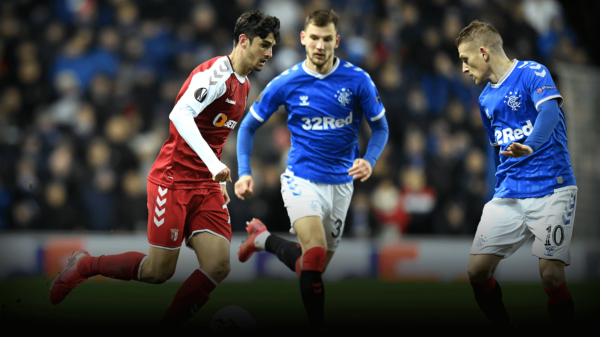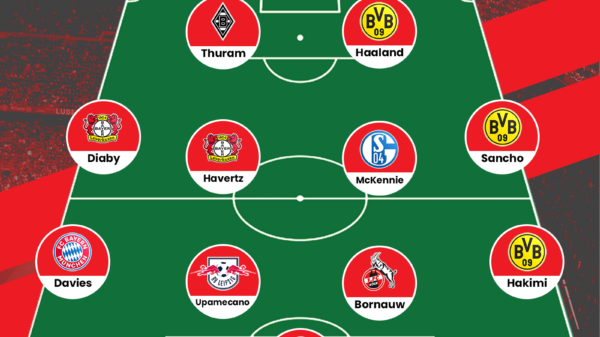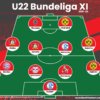
Chaitanya Jadhav writes a detailed article about Thiago Alcantara’s journey thus far, and why he thinks Thiago is the best midfielder in the world today.
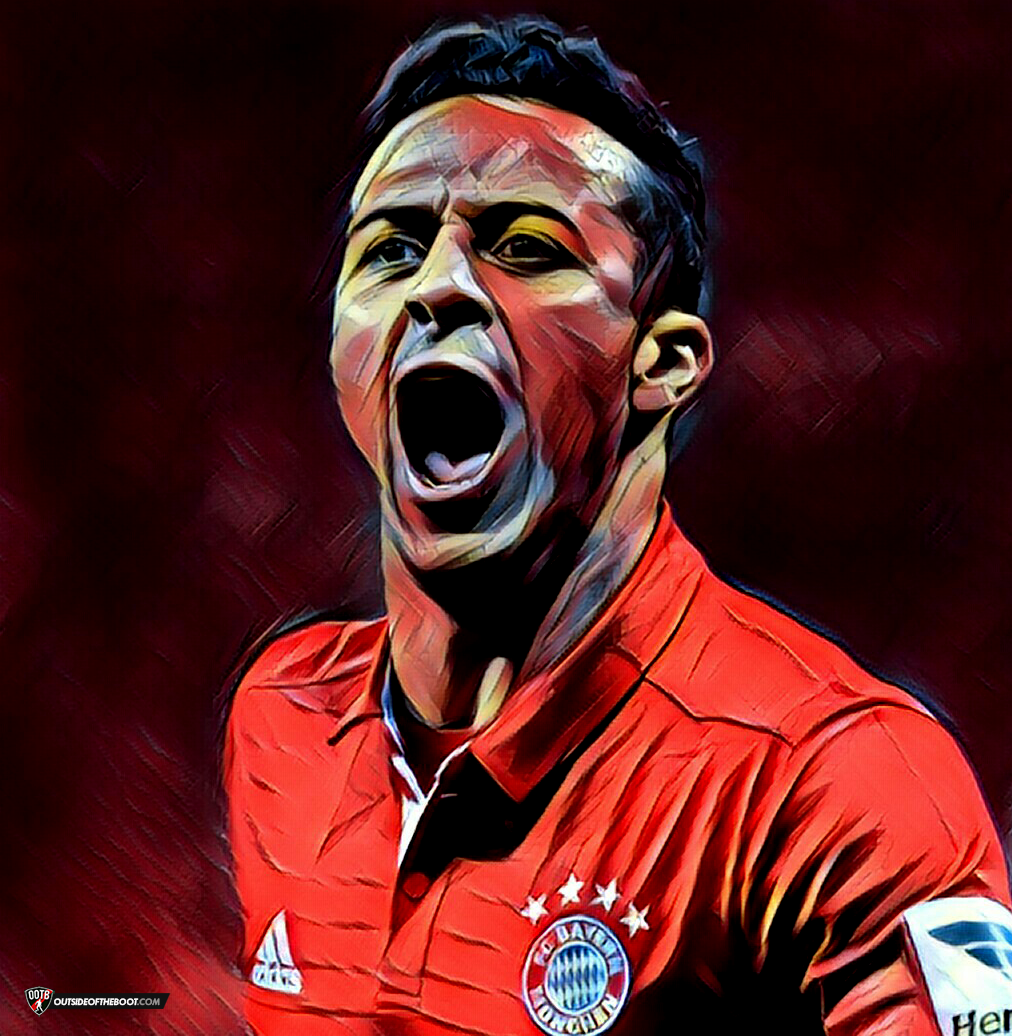
Despite being just 25 years old, Thiago has had a very illustrious and prosperous career. At Barcelona, he cemented his place in La Masia’s coveted list of promising young talents. Originally possessing the traits of an exuberant Brazilian, Thiago added a dimension of tactical awareness to his game at Barcelona and Bayern under a common mentor, the master of the midfield himself, Pep Guardiola. After enduring a rocky start to his metamorphosis, including serious injuries and inadequacies, Thiago has reinstated his name in the list of the world’s best footballers. The future has always been bright for the gem of La Masia, but he is currently on the cusp of cementing his name in the ever-expanding book of the greatest football players ever.
Mazinho, Rafinha, Humble Beginnings
Thiago’s childhood was his earliest foray in the world of football. His father, Mazinho, was a former World Cup champion and Santos legend, and was, undoubtedly, a great influence in his upbringing. Like most Brazilian footballers, he honed his skills on the streets, while drawing inspiration from the famous Verde-Amarela. Much of his early childhood intersected with the famous comeback of the national side, glorified with boundless talent from the likes of Romario, Jorginho, Ronaldo, Rivaldo and Ronaldinho.
His early youth career mainly consisted of him flirting with various teams, moving around along with his father from Brazil to Spain. Much of his early development occurred in Flamengo and Ureca, where he further sharpened his footballing skills, with healthy competition provided to him by his brother, Rafinha.
However, it was at the ripe age of fourteen that he was selected in La Masia, where his development accelerated rapidly. Under the tutelage of Cruyff’s principles, heavy competition from some of the world’s finest, and the promising manifestation of a prosperous career appearing before his eyes, Thiago rose through the ranks in meteoric fashion and found himself in the first team in the short span of three years.
Barcelona – The Diamond of La Masia
Brazil had an important role to play in the development of Thiago’s technical skills. This could be seen at the beginning of his stint at the Catalan club, where he used his Brazilian guile to bring the ball forward from his midfield position, beating two or three players before laying it off to his teammates who used the space that he created to move in advanced positons.
However, the heavy tactical emphasis that Spain placed on their players had its effect on him– the masterclass that Guardiola and Villanova gave him over the course of his three-year stint added another dimension to his play.
Thiago’s versatility and his jack-of-all-trades status allowed him to be played in a variety of formations, and in a multitude of positions. While most his time there was spent playing as a “Number 8”, he also played as a deep-lying playmaker, a wide midfielder, attacking midfielder or a winger, sometimes even alternating between those positions throughout the course of ninety minutes. His versatility, reinforced by his brilliant technical skills, allowed him to get involved in all the areas on the pitch, whether it be in the opponent’s half or his own. He excelled at everything that he was instructed to do – whether it was helping Iniesta or Xavi, lying in the halfspaces to create chances, or resting deep to aid with switching the play during overloads.
However, some would say that Thiago’s greatest showcase of his versatility was his stint under Tito Villanova, where he was employed to support Busquets in Barcelona’s defensive phase. His exposure to new playing styles and positions allowed him to undergo the first stage of his metamorphosis.
At the tender age of eighteen, Thiago regularly replaced the legendary Xavi when he needed a rest or when he was injured. The more he played, the more composed and comfortable he looked in his new positions. His brilliant performances ensured that he got increasing amounts of game time, and, soon enough, the Boixos Nois hailed him as the heir to the legendary Barcelona midfield.
Under the guidance of Guardiola and his arsenal of world-class midfielders, he progressed in leaps and bounds, both tactically and technically. The club saw him as an able replacement for Xavi and Iniesta, and made their best efforts to ensure that he couldn’t leave, tying him down to a contract with an exorbitant release clause of ninety million euros.
Statistics also seem to back this up – player radars (graciously made by @thefutebolist) show his improvement over his stint at Barcelona. From the radars, we can see Thiago’s brilliant vision and ability to pick out passes and contribute to goals – the consistency in those stats is remarkable, given the multitude of positions that he played in. However, the same statistics show room for improvement – like many young players, Thiago lost the ball often.
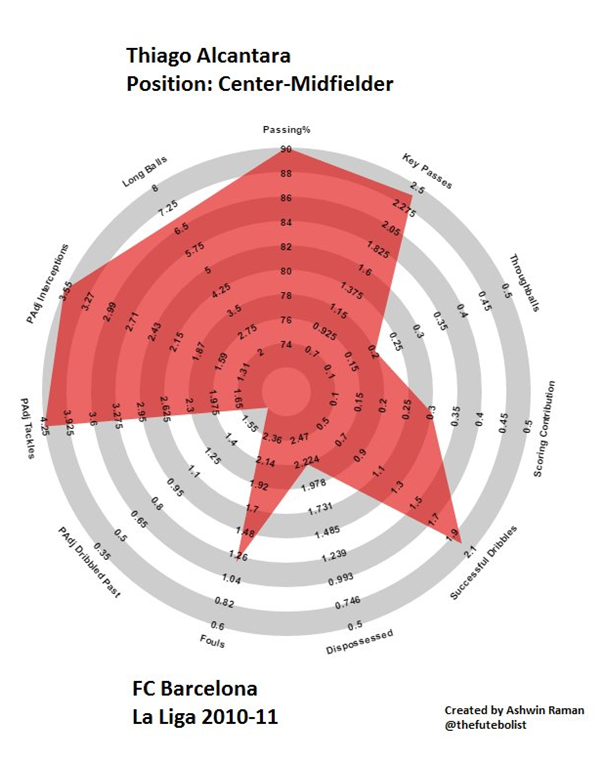
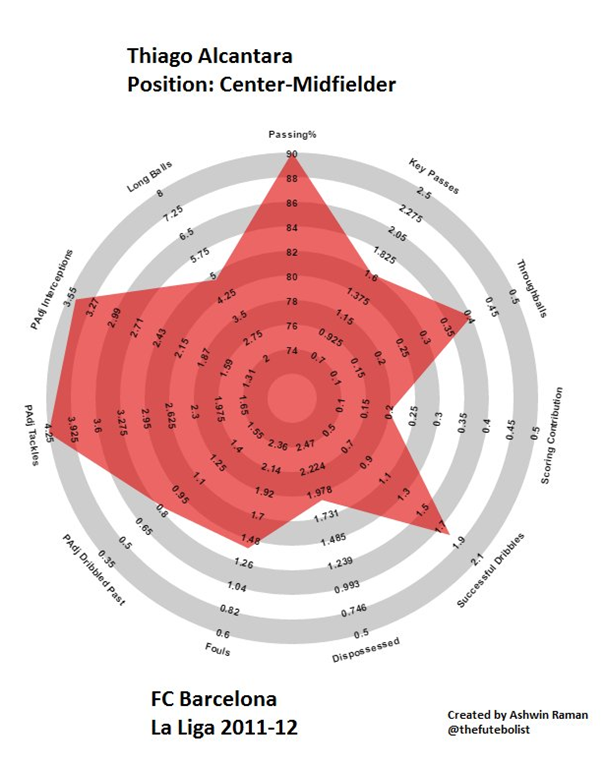
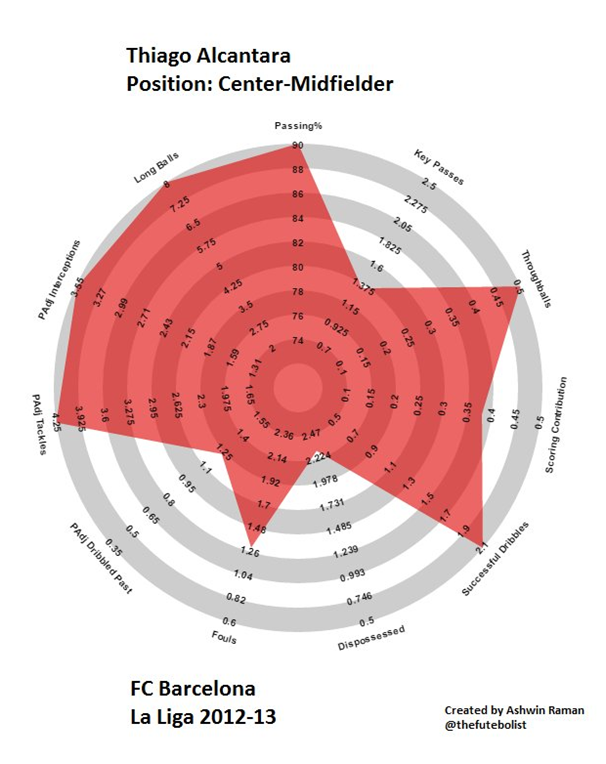
The player radars show us that Thiago effectively used his playmaking ability during his time at Barcelona – a feat we must respect. However, the shape of the radar changed because he was employed in different positions every season. The radars indicate an overall movement of position – from a more attacking midfielder to a deep-lying one – a change which, essentially, allowed him and his team to make the most of his talent.
Furthermore, Thiago also managed to carry over his shining domestic form to international tournaments – thanks to his brilliance, Spain won the 2013 UEFA European Under 21 Football Championship, with him bagging a hat-trick in the final against Italy.
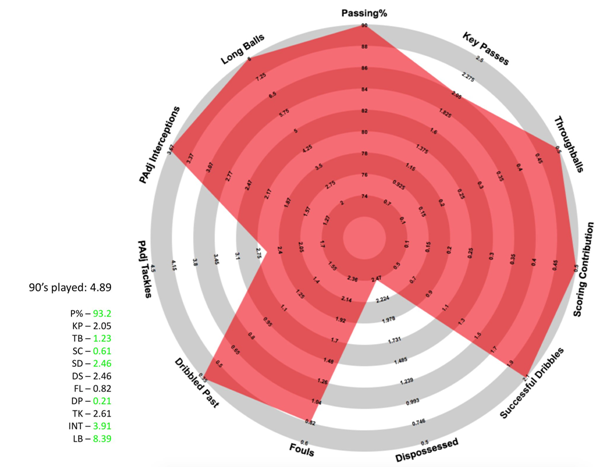
Thiago’s U21 EURO2013 (Credit – @fussballradars)
His future at the Catalan club looked bright, despite worries about him not getting enough game time. However, after Guardiola left for Bayern and came calling for Thiago, he packed up his bags and travelled to Bavaria to undergo the second stage of his metamorphosis.
metamorphosis
noun
- a change of the form or nature of a person into a completely different one.
Brilliant Minds in Bavaria
“Thiago order nichts”. Thiago or nothing. That was the ultimatum that Pep gave the Bayern board during his first season in charge. “He is the only player I want. It’ll be him or no one.’ Thiago was the first piece of his project in Germany. His transfer, however, did cause a lot of controversy, mainly because people were unsure about where he would fit in a Bayern side filled with world class midfielders.
However, Guardiola needed Thiago to help him to adapt to the German game. Pep’s original midfield pairing of Alonso and Schweinsteiger was the antithesis of the football that he wanted to play – although both players were world class, they often lacked mobility, technical brilliance and attacking prowess.
Therefore, in a new country filled with uncertainty, he needed a young, talented, yet adaptable midfielder that could allow him to create a playing style which blended the German game of counter attacking and Spanish game of possessive play.
Once again, Thiago flourished in his new club, and learnt quickly from the likes of Xabi Alonso, Phillip Lahm, and Bastian Schweinsteiger, who are masters of reading the game and picking out the right pass. Guardiola himself, a heralded player of Cruyff’s Dream Team, had a lot to teach to his jovial pupil.
His tactical adaptability was effectively utilized during his first season, with him, once again, being employed in a multitude of positions, as a lone pivote, a part of a double pivote, a number 10, a wide midfielder and a winger. His Spanish upbringing allowed him to play deep, recycle and retain possession along with Alonso and Lahm and his Brazilian instinct allowed him to take players on, move the ball forward and pass it in advanced positions.
I’d like to mention that Thiago’s unique rearing was essential for his success at Bayern – midfielders in the German club didn’t possess his unique skillset and mindset. Before his arrival, nobody in the squad had the confidence to take on defenders (apart from Robben and Ribery).
It’s very easy to draw parallels with Thiago’s fruition at Bayern and Barcelona. At the beginning of his first season in the Bundesliga, he played in a more attacking role, supported by the defensive minds of Schweinsteiger, Alonso, Lahm, and Rode. He excelled in those roles, playing instrumental parts in Bayern’s domestic and European campaigns.
However, we could see some discrepancies in Thiago’s play. Once again, he got into the habit of losing the ball often, and seemed lost from time to time. However, both shortcomings were understandable, given his lack of experience in a league which is heralded for its fast paced pressing and counter-attacking.
Unfortunately, Thiago had to bring his promising season to a premature close due to a knee injury that confined him to the sidelines for over a year. Once he came back, however, it was business as usual, with his performances improving virtually every time he stepped on the pitch.
This season, under another world class midfielder, Carlo Ancelotti, Thiago has succeeded yet again in winning over the heart of the Italian. Currently, he is used as a deep-lying midfielder, or in a more attacking role behind the striker, with Ancelotti trying to make him a specialist midfielder and elite controller. Once again, his player radars seem to back this fact up.
Thiago’s first season at Bayern saw him being played as a deep midfielder, with Pep making the most out of his development under Villanova. He had to make tackles and move the ball forward from there.
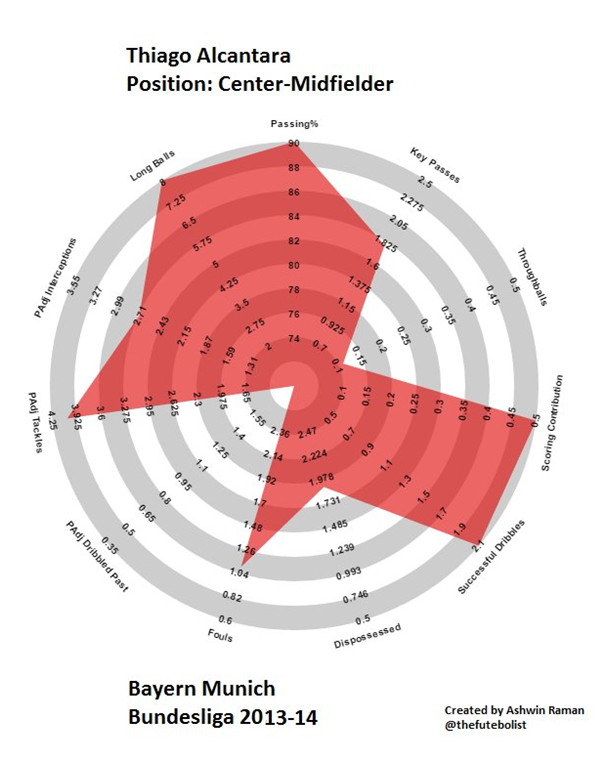
In the 2014/15 season, Thiago was used as a deep midfielder once again, tasked solely with the purpose of bringing the ball out from the back and switching the play during overloads. His ability to read the game and somewhat refined tackling method allowed Bayern to win the ball back in advanced areas, complementing Pep’s philosophy perfectly.

Currently, Thiago has another mentor to learn from, another world-class midfielder, Carlo Ancelotti, who is attempting to make him an elite midfielder by tying him down to one position. Under him, Thiago is becoming one of the world’s best, miles ahead of any other midfielder. With a calm mind and the willingness to use flair in his exploits, he has gone far above the rest of the midfielders in the world, with most statistics backing it up. This season, he has improved on his ability to retain the ball and has had a larger impact on his team’s goalscoring and chance creation. This is due to Ancelotti playing him as a midfielder with licence to attack, but with a slight responsibility to defend and recycle the play.
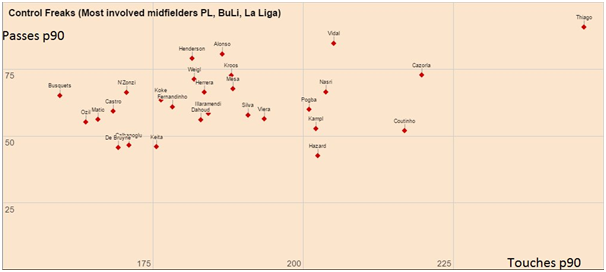
In my opinion, Thiago’s ongoing stint at Bayern is the culmination of all the experience that he has reaped. He has been employed in a multitude of positions, and has excelled in every one of them, making the most out of his subtle brilliance, understanding of space and tactical brilliance that he inherited from Spain and daring flair that he learnt during his time in Brazil. On the pitch, he’s a brilliant player, and off the pitch, a brilliant character, overcoming his devastating knee injury to beat the odds once again. The future is looking very, very promising for him.
Notes:
- Thiago’s player radars for 10/11 and 14/15 were made with a small sample size of 900 minutes, however, the writer that they needed to be included to provide a more concise image of his development.
- Credit for the player radars goes to Ashwin Raman (@thefutebolist). Without his work, there wouldn’t be enough material to make this piece.
- The Tale of Thiago: Transmutation, tragedy, and triumph - January 2, 2017
- Mario Balotelli: Tragedy, Comedy, and Perhaps a Miracle? - October 5, 2016
























































